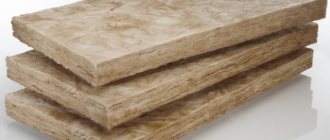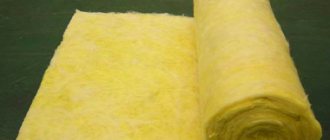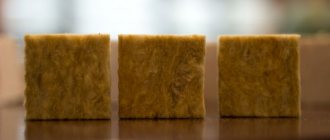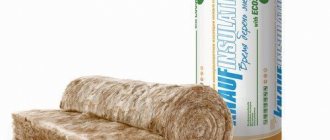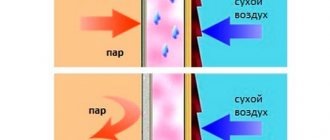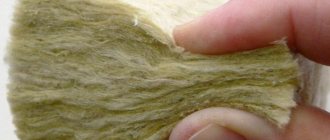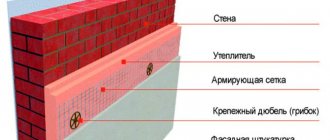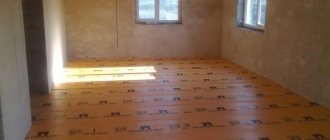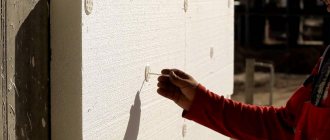It happens that a consumer buys mineral wool, insulates the walls with his own hands and hopes for a long service life of the product, but in reality the opposite happens. The material fails very quickly, the premises begin to freeze, and the user develops a negative attitude towards the product, which he expresses on forums on the Internet.
Alas, such situations are not uncommon, but the main reason is not a violation of installation technology, operating rules or incorrect preparation of the walls, but incorrectly selected dimensions or physical characteristics. In particular, the density and thickness of the slabs. To ensure that insulating walls outside with mineral wool does not become a waste of money, a potential buyer should familiarize themselves with the recommendations regarding the parameters of the material.
Thickness of mineral wool. Dimensions of mineral wool for floors, roofs, walls, comparison of manufacturers
For example, in terms of thermal conductivity, 20 cm of mineral wool slabs replace 2 meters of brickwork.
Ideal sound insulation of mineral wool boards The special fibrous structure of mineral wool boards makes it an ideal sound insulator. Non-combustible mineral wool slabs and fire resistance Non-combustible mineral wool slabs of the P-75, P-125 and P-175 series, as well as PPZh-200 are in the group of non-combustible and fire-resistant building materials, which greatly expands the scope of application of these brands of non-combustible mineral wool slabs. Hydrophobicity and vapor permeability of mineral wool slabs The mineral board is practically not wetted by water and does not absorb moisture, thus preventing a decrease in the insulating properties of mineral wool boards under the influence of moisture and water. In addition, mineral wool boards have good vapor permeability, preventing condensation from accumulating and continuing to maintain the necessary climatic conditions in the room. Elasticity and stability of mineral wool slabs of the P series Mineral wool slabs are very convenient for installation and cutting of material. Thanks to their special fibrous structure, mineral wool slabs have a very good degree of elasticity and resistance to many deformations. Durability and environmental friendliness of mineral wool slabs Mineral wool slabs contain absolutely no toxic substances and are completely safe for human life and health. Also, high resistance to environmental influences makes mineral wool boards a very durable material. In what cases are the dimensions of mineral wool taken into account? What sizes are mineral wool slabs? What sizes does stone wool come in? What material is convenient to work with?
General characteristics
The product is sold in two forms: slabs and rolls. The dimensions of the sheets are established by GOSTs. In the rolled version, the length of the mat can reach 10 meters, the width - from 1 to 1.5 meters. Slab parameters: 1250*610 mm. Thickness varies from 2 to 15 cm. Density is another important indicator, which indicates the number of fibers per 1 m³. On the packaging it is indicated by the letter P. Values from 35-150 are suitable for working with walls. The higher the value, the greater the load on the base.
Photo: Instagram @ooo_prosk
Photo: Instagram @rockwool_russia
Mineral wool for external insulation. Advantages of external insulation
Insulate housing from the inside only in the most extreme cases. The justification may be the impossibility of insulating the walls due to the height, or the authorities’ ban on changing the appearance of the structure. Insulating walls outside with mineral wool often spoils the appearance of an apartment building. A separately insulated apartment stands out noticeably and disrupts the architecture of the city. But the main reason why the process is carried out outside is thermal engineering and physics. There is a term - “dew point”. If the insulation is located from the street, the dew point moves away from the internal walls. The house is warm and cozy, the walls remain dry.
Placement of the dew point, depending on the method of wall insulation.
Placing insulation inside will cause the walls to become damp. You will need to invest a lot of effort and money into a vapor barrier. No less important reasons:
- The usable area inside the apartment does not decrease. There is not a single case when a person wants less free space.
- The outer wall of the house is perfectly protected from all negative factors of nature.
- Good indoor ventilation.
- The appearance of the building is improved. You can hide gloomy gray walls, create a unique design and update the facade. This is very beneficial if you decide to sell your home.
Material
There are many options for wall insulation.
Modern technologies have filled this market segment. The most commonly used insulation is mineral wool. It is also called basalt, because it is made from natural raw materials - basalt. An additional component is silica. During the production process, the product is treated with water-repellent compounds. Everything is thought out in such a way that vapor permeability does not become worse. The building material is supplied to the client in the form of mats and slabs. A less convenient form of delivery is in rolls. The parameters of the final product may vary. The material itself has a fibrous structure. The fibers can be oriented in all sorts of ways. When positioned “parallel” we have conventional slabs. If the fibers are oriented perpendicularly, these are lamella slabs. Most often, the walls of buildings are insulated with cotton wool with a density of 75 to 145 kg/m3. A low-density slab can be attached directly to the wall. Low density allows you to fill all the unevenness in the wall (brick, concrete). It is customary to mount slabs with a density of 100 kg/m3 above the first layer. They allow you to get a smoother surface and make finishing work easier. To calculate the required quantity, you must proceed from the total area of the walls. From the resulting amount you need to subtract the sizes of windows and doors. A reserve of 5 to 10% is quite justified: you will spoil something, and the remainder will be useful on the farm.
Advantages of mineral wool
The material has significant advantages:
- Complete, high-quality filling of all voids. This cannot be achieved using polystyrene foam.
- There is no need to use a vapor barrier.
- The insulation technology is not particularly difficult.
- Fire resistance. The material does not burn and does not support combustion. It can withstand almost 6 thousand degrees of heat.
- Long service life if all installation requirements are met.
- Light weight. Mineral wool is easy to work with and does not place much load on the walls and foundation.
- Excellent thermal insulation.
The minimum total thickness of the insulation should be ten centimeters! The best option is to attach the insulation to a load-bearing wall, and then lay the brickwork using facing bricks. The insulation layer is located in the middle, is perfectly protected and “works” more efficiently. Mineral wool can be used to insulate a wooden house or a brick house. Sometimes buildings made of gas silicate blocks are finished with mineral wool. This action is justified if you live in the northern regions. But significant thickness is not required.
Plates
Stone wool slabs are convenient to mount on walls and ceilings. They are often denser, which makes working with it more comfortable – cutting, fixing, plastering. With it, the joints are of better quality. Due to their increased density, the slabs are more resistant to loads and absorb less moisture. The sizes of slabs (sheets, mats) are very diverse, so before buying, you need to carefully measure the dimensions of the area to be insulated. You should also pay attention not only to the dimensions of the slabs, but also to the structural features - some of them have a tongue-and-groove system, which greatly facilitates the installation process. In this design, the heat insulator can be used for insulation:
- Ventilated facades.
- Polov.
- Stan.
- Frame structures.
- As a sound insulator in any room.
Since the slabs are packed in a sealed shrink film, you should not focus only on the volume of the packaging; you should pay attention specifically to the dimensions of the individual mat. The average width/length is 1/2 m. If necessary, sometimes manufacturers accept orders for the production of non-standard sizes, but not all of them.
Mineral wool in rolls
Mineral wool in a roll
Such dense stone wool can be cut and trimmed to the required parameters. Some dimensional characteristics of well-known manufacturers involved in mineral wool:
- Knauf - slab length - 1.25 m, width 60 cm, thickness 5 cm.
- Isover – 1.17 m/56.5 cm/5-10 cm.
- Technique – 1.2m/60cm/10cm.
- Rockwool and Ursa have standard lengths of 1 and 1.25 m, but the width and thickness are different.
